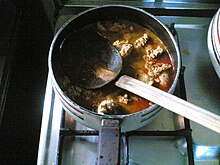Mangalorean Catholic cuisine

The Mangalorean Catholic Cuisine is the cuisine of the Mangalorean Catholic community and is largely influenced by Mangalorean, Goan, and Portuguese cuisines.
Mangalorean Catholics are Roman Catholics from the Mangalore City and the former South Canara district on the southwestern coast of India. They are Konkani people and speak the Konkani language. Most of the ancestors of Mangalorean Catholics were Goan Catholics, who had migrated to South Canara from Goa, a state north of Canara, between 1560 and 1763 during the Goa Inquisition and the Portuguese-Maratha wars. The culture of Mangalorean Catholics is a blend of Mangalorean and Goan cultures. After migration, they adopted the local Mangalorean culture but retained many of their Goan customs and traditions.
Non-vegetarian cuisine

Their curry uses a lot of coconut and curry leaves while Ginger, garlic and chilli are also used. Mangalorean Catholic cuisine has distinct Portuguese influence as can be seen in Laitao, the famous roast served as the Pièce de résistance at wedding dinners, and Pork Sorpotel. Mangalorean Catholics mix pork blood and other parts in most of their pork delicacies as can be seen from Pork Bafat, Cabidella and Kalleze un Kiti (Heart and Intestines). Sanna-Dukra Maas (Sanna – idli fluffed with toddy or yeast; Dukra Maas – Pork)[1] and Unde-Dukra Maas (Unde – leavened bread; Dukra Maas – Pork) are popular dishes. Bifa Maas (beef) is also popular. The traditional Rosachi kadi (Ros Curry), a fish curry made with ros (coconut milk) is quite popular and is served during the Ros (anointing) ceremony that is held 1 or 2 days before a Mangalorean Catholic wedding. Their fish curry especially their Fish Roe Curry, is known for its taste in the whole of coastal India while fried fish in their style is well known. The Sheveo Roce and Pathal Bakri (a variant of Kori Rotti) are popular chicken delicacies.[2]
Vegetarian cuisine

The "Balthazaar Chutney" is a popular condiment. The dish originated when Balthazaar, a Mangalorean Catholic nobleman, was taken prisoner by Tipu Sultan in 1784 during the Captivity of Mangalorean Catholics at Seringapatam. Unable to stomach the indifferent camp food, he offered to make a chutney for the captured Mangalorean Catholics.
The "Pollu", a type of Sambar with Galmbi (powered dried fish) or Kambulmas (Dried Tuna) is popular. The traditional "Fode" is a popular pickle. Thail Piao, which means literally vegetables dumped with oil and onions and left to boil on the fire wood is quite popular. Karamb (Cucumber salad) and Foka (Lady’s finger combined with cashewnuts). The Appam and Panpole are popular delicacies made of soaked rice, water and salt. The Thath Bakri is made with ground red boiled rice mixed with raw scraped coconut and roasted on a tawa on a banana leaf. The Mitais, Mandas, Ushae, Pitae and Mani are well known sweet dishes.

Kuswar is a term often used to mention a set of unique Christmas goodies which are part of the cuisine of the Mangalorean Catholic community There are as many as 22 different traditional recipes that form this distinct flavour of Christmas celebration in Mangalore. Neuries are puffs stuffed with plums, nuts, and fried theel (sesame) and sugar. Kulkuls are curly concoctions dipped in sugar treacle, pathekas are savoury of green nandarkai bananas, theel laddus and jaw snapping "Golios". Macaroons is what Manglore is famous for and the subtle flavored rose cookies are a hot favorite. But it is the Rich Plum Cake which takes the better part of a week to make. Candied fruit, plums, currents, raisins are dexterously cut and soaked in rum. Flour sieved and gently warmed in the sun. Nuts shelled and chopped and the whole family comes together to make the cake. Jobs are allotted, one to whip up the eggs, while another creams the butter and sugar, cake tins are lined, and a strong pair of arms requisitioned to do the final mixing and stirring.
Patrode, a dish of colocasia leaves stuffed with rice, dal, jaggery, coconut, and spices is also popular.
Notes
- ^ Stephen D'Souza. "What's in a Name?". Daijiworld Media Pvt Ltd Mangalore. Retrieved 2008-03-04.
- ^ "Typically home". The Hindu. 2007-08-11. Retrieved 2008-07-09.
{{cite news}}: Check date values in:|date=(help); Italic or bold markup not allowed in:|publisher=(help)
External links
- Mangalorean Catholic Cuisine by RoseMary Albuquerque Pai from The Summer Sands Online newspaper
